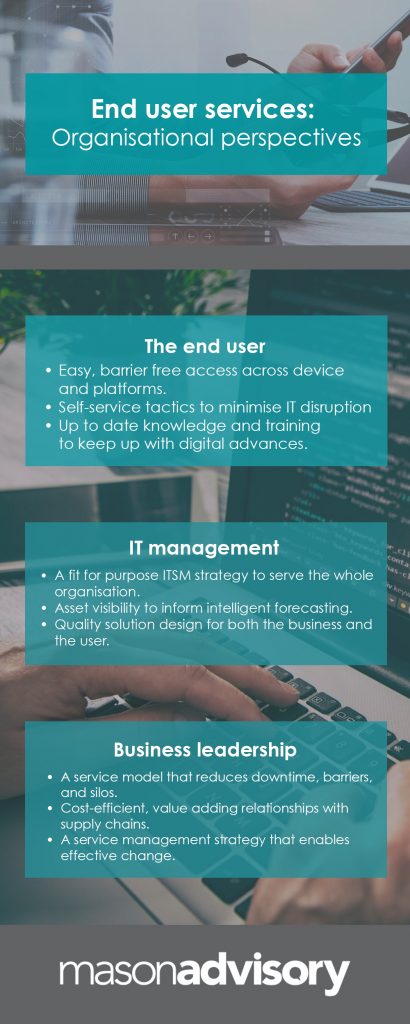End user services: Managing the future of post-Covid working
Share:
Date:
July 2020

key fact
More recently, Gartner has examined the future of work trends post Covid, with data suggesting that nearly half of employees will continue to work remotely for at least some of the time.
Our series of articles on the post-Covid reality has, so far, tackled the issues IT will need to address in a new culture of remote working. Joined up thinking will be important to ensure that the needs of end users (and hence customers) are met. Across hardware, software, security, connectivity, and governance, the service management model also needs reinvigorating to ensure it aligns to, and drives forward, emerging priorities and working practices. So, in this article, we explore:
- How shifting user capabilities are changing the ITSM outlook.
- Why the service management model must be streamlined to enable agility and productivity.
- How revisiting the ITSM strategy will enhance IT’s role an as enabler of the business.
As far back as April 2020, Microsoft was predicting that Coronavirus will cause our work habits to change forever (The Verge). More recently, Gartner has examined the future of work trends post Covid, with data suggesting that nearly half of employees will continue to work remotely for at least some of the time. The same report predicts that organisations will become more complex, as they attempt to manage risk through strategies such as diversifying geographically. Leadership will face new challenges as operating models evolve. So, too, will IT – since the digital strategy will need to be revisited to support the organisation.
Understanding the end user perspective
This outlook is particularly relevant when it comes to end user services, not least when we consider how the pandemic has influenced changes in the service model. In recent years, we observed a move away from “log and flog” tickets via faceless global service desks. Larger companies, in particular, implemented on-campus tech bars, walk in centres and the like. The rationale was one of accountability and meaningful access for users, and companies invested heavily.
Now, Covid has pushed the global service centre back into the limelight. Innovative organisations are working to bring a new human angle into the virtual model, introducing names, faces and an element of relationship into remote support desks. Advances in AI and Machine Learning are driving new capabilities in automated incident management. Plus, the move to SaaS models has encouraged us all to adapt to automatic updates, new features and changing functionality as they hit our devices. End users during the pandemic have become more self-reliant – facilitated in part by necessity and in part because of the vast attention that tech providers have paid to intuitive interfacing. We can expect to see the focus of support enquiries change, as self-service becomes embedded into the user experience. But that does not negate the need for well-structured access, training and support, especially as new technologies come to market rapidly. What will change is the way in which service management will need to accommodate remote, office and hybrid working simultaneously.
The role of service management in driving organisational strategy
This is an opportunity for IT to shift its focus. As we move from a kitchen sink “get it done” mantra into more stable times, workforces are emerging more equipped to independently onboard, problem-solve and fix fast. As mentioned in our article on connectivity, platforms and apps that have carried us through the pandemic will be keen to build on their share by monetising offerings. The result will be a fiercely competitive marketplace. That sets the scene for IT to streamline its end user portfolio. Lessons learned from remote working will inform the most efficient and effective strategy moving forward. ITSM will be the support vehicle through which users maximise the capability of new toolkits.
Proper enterprise architecture will be crucial to adapting the digital portfolio to these new parameters. The issues need to be tackled with an end-to-end viewpoint. High-level strategic decisions on governance, security, connectivity, and the device pool should be considered in alignment with each other – and with end user capability in mind. Service management should be an integrated part of that strategy, not viewed as an optional bolt on. IT needs to revisit service management design with the future of the business and barrier free working as its driving principles.
Aligning with all of this is the vital role of people management. As CIO.com points out, a key challenge of remote support in a post-Covid environment will be achieving organisation-wide buy-in for new strategies focused on flexibility, up to the minute knowledge and pro-active support for users. As we come out of the pandemic, accommodating these considerations will underpin staff’s wider wellbeing and positive working outlook, even as times remain uncertain.
Equipping workers to deliver the competitive edge
Moving forward, businesses are turning their minds to the recovery and change opportunities coming into view. The C-suite will expect IT to minimise down time, remove barriers and silos, enable effective change, and deliver in a cost-efficient manner. Marry that with the likelihood of geographically scattered workforces and complex considerations come into play. Intelligent workforce analytics will be a key component in designing quality service management solutions, built with business and user principles in mind. This can be achieved by building on existing relationships with strategic partners and vendors to review service schedules and aging agreements
Ultimately, IT should embrace its role as the enabler of the business and its people. A responsive, imaginative service management model will equip the business to ensure that users are focused on their roles – not firefighting technical difficulties. Productivity and accountability will both be watchwords. For IT, this is an opportunity to add value to the executive strategy, streamline efficiencies for the business, and enable users to perform to the best of their ability, future success.
Find out more:
Read our other articles in our post-Covid reality series, starting with IT’s role in driving distributed working.
Get inspired with our industry insights and case studies.
Explore Mason Advisory’s approach to real-world enterprise architecture.
Author: Jagjeet Pandha
Published: LinkedIn

